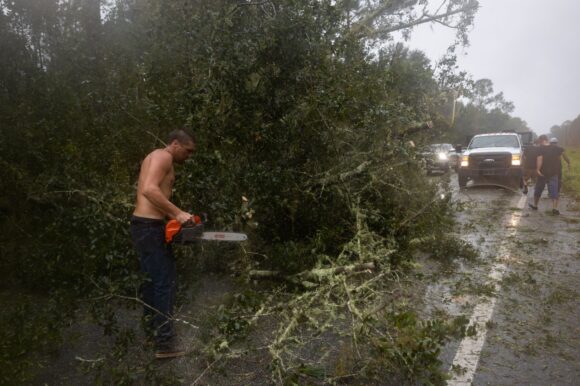Around the world, insured damages inflicted by natural catastrophes are climbing fast and set to double in roughly 10 years, the Swiss Re Institute — the research arm of the giant reinsurance firm — said in a report published Tuesday.
The financial repercussions for policyholders will be painful if the trajectory continues as predicted. “Premiums have to move in line with this risk,” said Jerome Jean Haegeli, Swiss Re’s chief economist and the lead author of the report.
Insured losses from natural catastrophes have been on a slow and steady rise. Although last year saw a drop from 2022 and 2021, it was the fourth year in a row when they topped $100 billion. Only about 40% of economic losses globally are insured, meaning the total economic losses are much higher.
Historically, years with major hurricanes like Harvey (2017) or Katrina (2005) were spikes that drove global insured damages past the $100 billion mark. But recent years have seen a marked increase in smaller events — most commonly severe thunderstorms — that cause great destruction.
Hurricane Idalia Strikes Florida With Powerful Category 3 Winds
Residents try to cut their way through downed trees to return to their homes following Hurricane Idalia in Steinhatchee, Florida, US, on Wednesday, Aug. 30, 2023. Hurricane Idalia knocked out power to hundreds of thousands of Florida customers, grounding more than 1,800 flights and unleashing floods along far from where it came ashore as a Category 3 storm earlier Wednesday. Photographer: Christian Monterrosa/Bloomberg
Last year’s highest-loss event was the February earthquake in Turkey and Syria, a tragedy that took some 58,000 lives. Insurance penetration in the hardest-hit region was very low, and insured damages from the earthquake came to about $6.2 billion.
By contrast, 18 thunderstorms in 2023 caused over $1 billion in damage each, adding up to a record of $60 billion. The US, which is relatively highly insured, experiences a disproportionate number of thunderstorms and saw 85% of last year’s damage. Convective storm, or thunderstorm, losses — characterized by sudden downpours, fierce winds and hailstones — have been growing by about 7% annually for 30 years.
2023 was the hottest year on record, due to planet-warming greenhouse gas emissions, and this January and February were both the hottest recorded so far. Science is just beginning to connect the dots between more thunderstorms and rising temperatures caused by climate change. “Thunderstorms thrive in a warm, moist environment,” Bernadette Woods Placky, chief meteorologist at Climate Central, a nonprofit that acts as a climate research clearinghouse, told Bloomberg Green in December when Swiss Re released preliminary 2023 natural catastrophe loss numbers.
Inflation is largely to blame for the rise of thunderstorm damage, Swiss Re says, followed by population growth in high-risk areas. Changing behaviors, like the growing use of solar energy, also had an impact. “Hail is by far the main loss-making culprit of SCS [Severe Convective Storms],” the report says, and “aging roof tops, which increasingly host (glass) solar power system installations, a main victim.”
Swiss Re estimates that climate change was responsible for only a fraction of increase in damages, about one-eighth, although it expects that its contribution will rise. With factors like inflation, exposure and rising natural perils combined, total insured losses will likely rise 5% to 7% a year over the next decade.
In the US, homeowners are already struggling under rising insurance premiums. Average home insurance rates rose by 7% nationally between 2021 and 2022, according to Insurify, an insurance cost comparison website. In states with recurring disasters, including Florida, California and Louisiana, costs are rising even faster and forcing many people to get coverage from state insurers of last resort, which are often priced under market.
Haegeli said the trend of higher rates would continue until governments take more steps to guard against threats. Building codes are important, he said, but funding mitigation can be expensive. “In order to finance climate adaptation, we are going to need private capital,” he said, and to mobilize that will take a lot more standardization in the financial tools that would enable it, like infrastructure bonds.
Top photo: Residents try to cut their way through downed trees to return to their homes following Hurricane Idalia in Steinhatchee, Florida, US, on Wednesday, Aug. 30, 2023. Hurricane Idalia knocked out power to hundreds of thousands of Florida customers, grounding more than 1,800 flights and unleashing floods along far from where it came ashore as a Category 3 storm earlier Wednesday. Photographer: Christian Monterrosa/Bloomberg.
Was this article valuable?
Here are more articles you may enjoy.


 Bayer Gets Supreme Court Hearing in Challenge to Roundup Suits
Bayer Gets Supreme Court Hearing in Challenge to Roundup Suits  Musk’s xAI Faces California AG Probe Over Grok Sexual Images
Musk’s xAI Faces California AG Probe Over Grok Sexual Images  Edison Sues LA County Over Fire Deaths for Delayed Alerts
Edison Sues LA County Over Fire Deaths for Delayed Alerts  Munich Re: Insured Losses From Wildfires, Storms and Floods Hit Record High
Munich Re: Insured Losses From Wildfires, Storms and Floods Hit Record High 